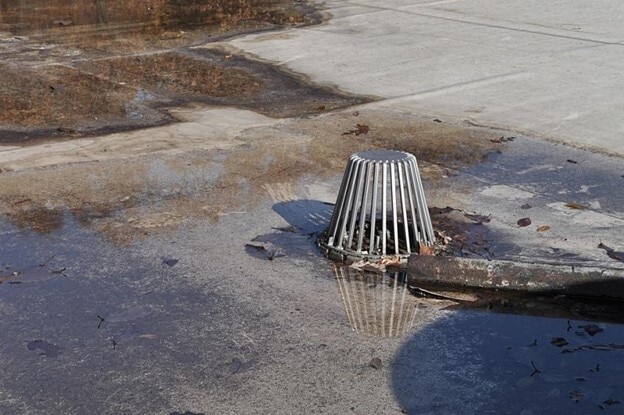A low-slope commercial roofing system is responsible for keeping the elements out of the building. During heavy rain, water with nowhere else to go may pond on the roof. A roof drain prevents water from ponding by providing a way for it to leave the roof, and regular commercial drain maintenance ensures its continued performance.
Although commercial buildings may appear to have flat roofs, some roofs have slopes built into the structure or require added slopes, typically achieved with tapered insulation to facilitate water drainage. This slope is designed to guide water to a drain, so it doesn't sit on the roof and damage the roofing system or structure. Standing water can slowly deteriorate certain roofing materials and cause premature degradation, failure, or damage. It can also promote algae and plant growth and attract nuisances such as birds and insects.
Guiding Water off the Roof
Residential roofs have gravity on their side—water flows down the slopes into gutters that transport it away from the home. Commercial buildings with low-slope roofs have to work a little harder to remove water, which is where roof drains come into play.
The roofing system design can help guide water toward the drains. It often involves using tapered insulation such as GAF EnergyGuard™ tapered polyiso insulation. The two most popular tapered boards deliver a 1/8-inch or 1/4-inch per foot slope. This slight slope prevents water from standing on the roof, forcing it toward a drain strategically installed at various low points on the roof with crickets and saddles.
Drain placement is particularly essential when the parapet wall sheds water. To help water arrive at the drain line or gutter, tapered crickets are typically installed in corners and between drains to direct the flow and alleviate ponding. This water must flow down the roof side of the parapet wall and follow the roof slope to reach the drain.
3 Common Types of Roof Drains
Inner Drains
Inner drains are connected to sloped pipes under the roof that carry water off the roof and away from the building. They typically rely on gravity and the roof's slope to get water to the drain.
Scuppers
Scuppers are found at the roof's edge, usually installed through a hole in the parapet wall. They're designed to drain water from the roof into a downspout or may extend out from the building to shed water.
Siphonic Drains
Siphonic drains feature a baffle that keeps air out and allows water to fill the pipes. Once the pipes are full, the lack of air creates a vacuum that siphons water from the roof at a high velocity. The baffle also keeps leaves and debris from gathering in the drain and causing a blockage.
Caring for and Maintaining Roof Drains
Inspecting and maintaining roof drains should be part of your regular roof inspections. Because roof drains are located at low points on the roof, it's easy for debris or leaves to build up in these areas. Clearing debris is essential for the drains to function properly. Clogs encourage pools of water to form on the rooftop, which can cause structural issues for the building. Even just an inch of standing water can add thousands of pounds of weight to the roof, reinforcing the need for regular commercial drain maintenance.
Advancing Roof Drain Maintenance with Technology
GAF recently introduced the Steely Drain™. This is a roof drain solution that leverages technology allowing contractors to build their maintenace relationship by setting up building maintenance reminders to contact building owners or facility managers. This contractor-inspired drain is made of 316L marine-grade stainless steel, making it ideal for tough environments that require exceptional corrosion resistance.
Steely Drain™ features a QR code etched onto the top that you can scan with your smartphone to instantly view information about the roofing system. This data can include the contact information of the contractor who installed the system, the architect and consultants for the project, and the roofing system details if all information is inputted.
This critical data is managed from a convenient GAF-hosted dashboard and plays an important role in the roof's maintenance plan. Contractors can set up and receive email reminders when it's time to perform scheduled roof and drain inspections. The dashboard also eliminates the need for core cuts since every detail of the roofing system is available through the QR code—from the deck type to the cover board, underlayment, insulation type and thickness, to the final membrane.
Knowledge Is Key to Success
When properly installed and maintained, roof drains can keep the rooftop free of standing water for many years. Curious to learn more? Explore how the Steely Drain™ can help you with your ongoing maintenance programs. You can also visit the GAF CARE Contractor Training Center to gain additional tips and access valuable training courses that allow you to learn at your own pace.

